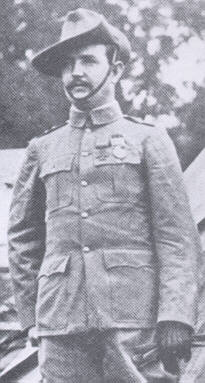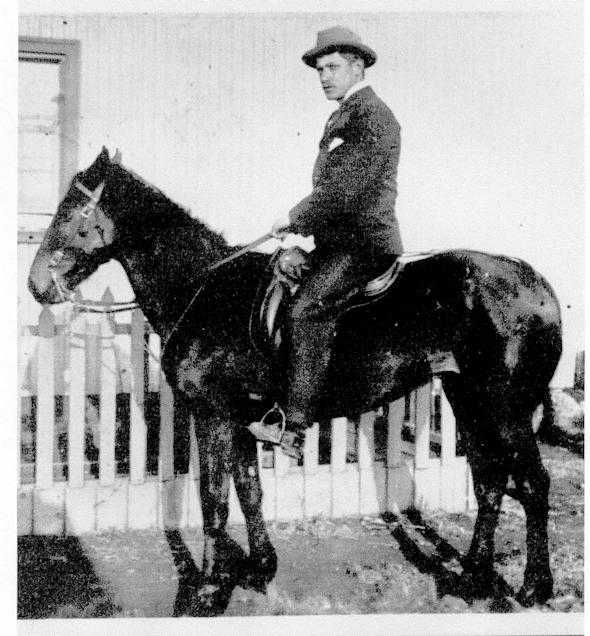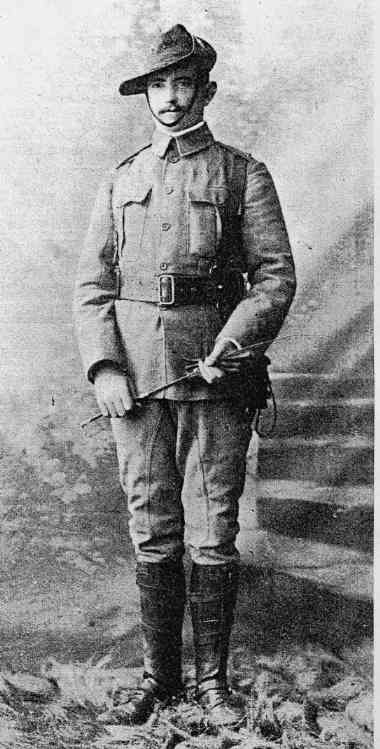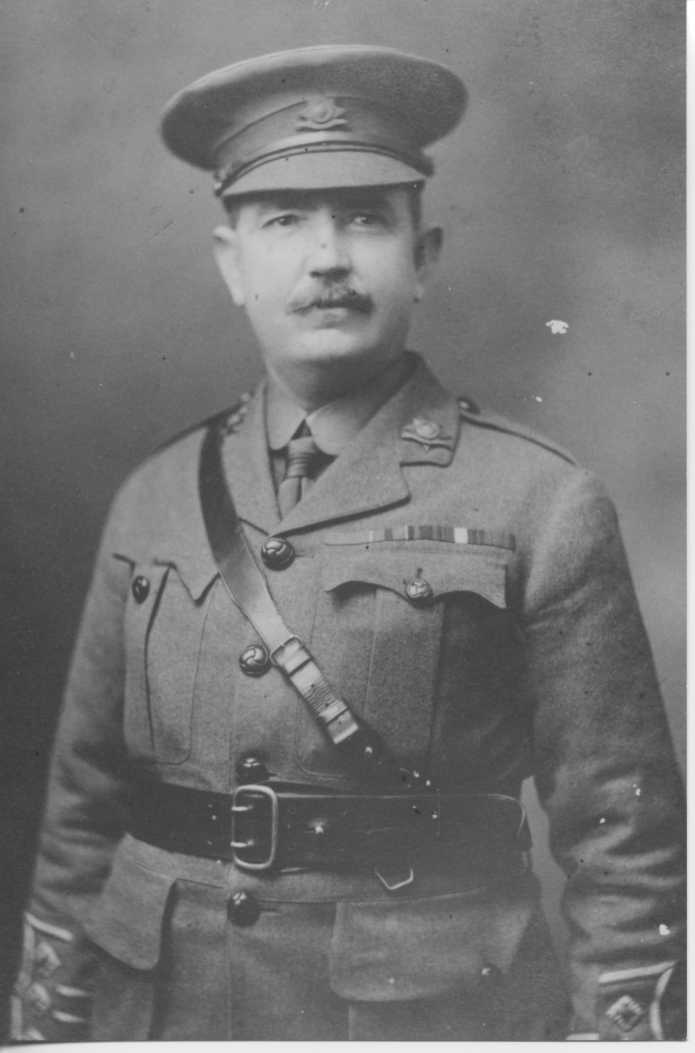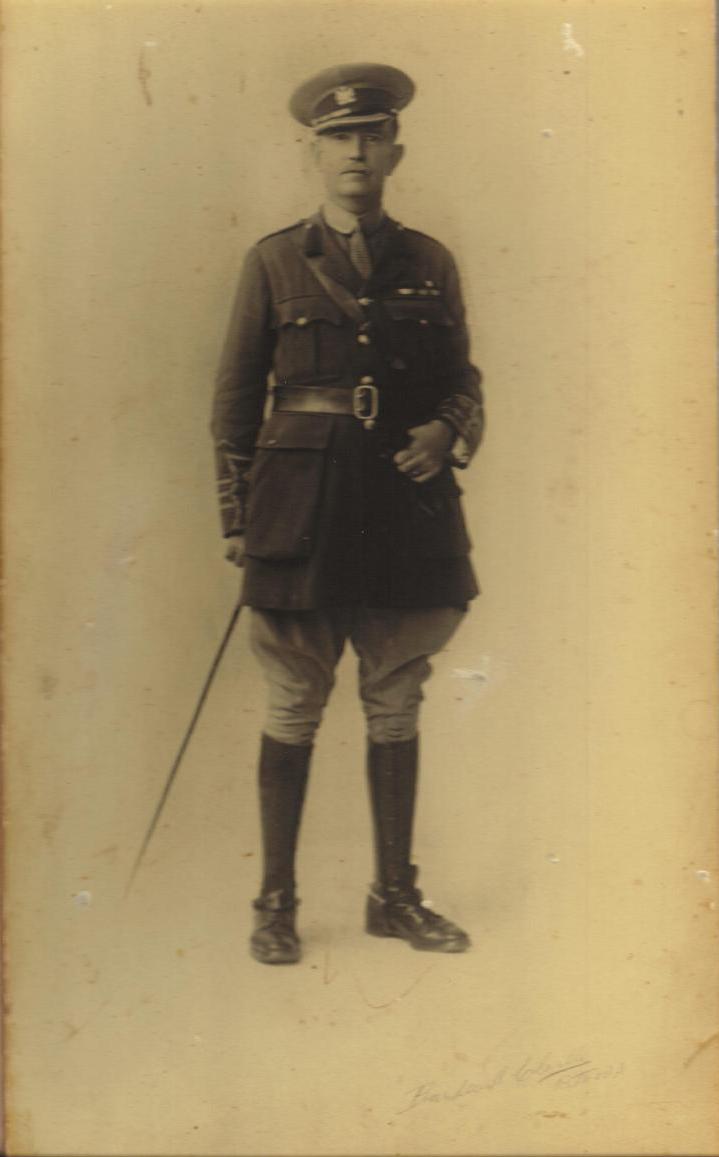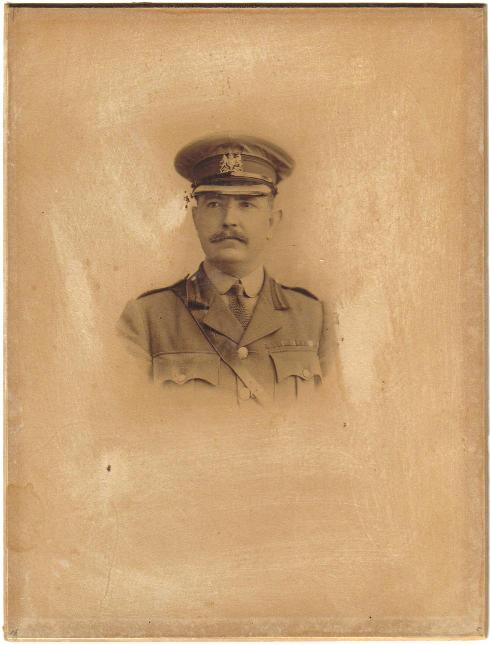The Search for Lt Col FW Bell VC
It all started with walks through a local cemetery. In 1993 I retired from 28 years as a Consultant Pathologist at Frenchay Hospital in Bristol. For the 8 years or so prior to that I had also been one of the three Medical Referees for the City of Bristol, a job I still do. This means that on two evenings a week I have to check all that day's applications for cremations. Each application consists of a set of papers with about 40 questions which have to be answered by an appointed member of the deceased's family and by two independent doctors. When happy that all answers are correct then I am empowered to grant permission for cremation. Before my retirement the sets of papers were delivered to my house, but now I tend to walk to the office at Canford and check the papers there. The office is at the entrance to this beautiful cemetery, at the start of an elegant avenue of trees leading up to the original chapel at the very top. Many superb trees decorate the grounds and they are full of birds and squirrels. The graves lining the avenue are often large and grand and there is absolutely no sense of foreboding anywhere; my grandchildren loved going there.
My house is not far away from the back entrance, a ten minute walk along some of the many public footpaths which cris cross this part of Bristol. These paths were originally the ways between the fields before the houses came in the late 1920s and early 1930s. In places the footpaths still resemble country lanes and it is easy some times to forget that you are in the suburb of a big city. My walk to the cemetery became one of the bonuses of the job.
Although many of the graves are large and elegant, others are less so; some are frankly near-derelict and others uncared for. This is one of the consequences of burial tradition in this country; frequently there is no family around to care for the grave of someone who died 80 or so years ago. In Germany, a country I know well because I have a German wife, graves are uniformly well tended since they are re-used every few decades and family is nearly always there. Some of the graves near my back entrance fall into the uncared for and partially derelict categories. Just inside the entrance is a special grave I first noticed in the autumn of 1995. Its headstone leant a bit, the "kerbstones" marking the plot were also tilted a little; the plot itself was uncared for and partly covered with weeds. The headstone read:
"In Dear Memory of my beloved Husband, Lt Col FW Bell VC, of Perth, WA. Died 28th April 1954, aged 79. For Ever and Ever".
What was an Australian VC doing in this Bristol cemetery? Other Commonwealth soldiers can also be found buried, but these overwhelmingly died of their wounds in one of the many WW1 Bristol Military Hospitals. Col Bell clearly didn't fall into this category. I was intrigued. I asked the foreman gardener if he had any idea; he hadn't. I felt a real need to know more and, if possible, locate some family in order to take the first step in what I hoped would result in some improvement to the grave - currently, I felt, an inadequate resting place for a brave man. Where to turn?
The first real inquiry I made to the local branch of the Royal British Legion. The cemetery contains an impressive War Memorial, near the top of the main avenue, and the Legion always lay poppies there on Remembrance Sunday; they also put poppies on the many War Graves that are scattered around the grounds. No poppies appeared on FW's grave on Remembrance Day 1995 and it turned out that the Legion had no knowledge of him. (There's another VC's grave too, and I don't think they know of that one either (see footnote 1)).
So far I had thus reached two dead ends. However, inspiration came. In early December I rang British Telecom and was given the phone number of the Victoria Cross and George Cross Association in London. A call to them elicited details of why FW had been given his medal. They gave me their address and I immediately wrote and confirmed the details I had verbally given them. Over the phone they promised me a copy of his entry in the VC & GC book. Christmas came and went and the promised details didn't; so, in frustration, I wrote again on January 8th 1996. The details came a few days later. They included a photo of FW and read:
"BELL, Frederick William
Lieutenant (later Lt Colonel) West Australian Mounted Infantry
Other Decorations:-
Date of Gazette: 4 Oct. 1901
Place/Date of Birth: Perth, Western Australia - 3 Apr. 1875
Place/Date of Death: Bristol - 28 Apr. 1954
Memorials: Canford Cemetery, Bristol; Australian War Memorial, Canberra
Town/County Connections: Bristol
Remarks: Served in First World War - Commandant Embarkation Camps, Plymouth; After the war was Political Officer, British Somaliland, then Administrative Officer, Northern Nigeria and Kenya Colony.
Account of Deed: On 16 May 1901 at Brakpan, Transvaal, South Africa, when retiring under heavy fire, Lieutenant Bell noticed a man dismounted. He returned and took him up behind him, but the horse not being equal to the weight, fell with them. The lieutenant then remained behind, covering the man's retirement until he was out of danger."
At last I had made a start, but what of Mrs Bell? She had clearly outlived her husband, but the dates and time scale made it most unlikely that she was still alive. Why wasn't she buried with her husband? Had she gone back to Australia? Were there any children of the marriage and, if so, where were they? The questions kept popping up.
On February 24th 1996 The Times carried an article about the efforts of a London policeman to locate the unmarked grave of one of the first holders of the VC who died in 1857. Not only had he been successful, but he had raised enough money to erect a headstone, with enough left over to do the same for another VC's unmarked grave. The policeman had even located family in New Zealand and they had attended the headstone ceremony. I thought that if this is possible with someone who died in 1855, then I ought to be able to do something for someone who had died in 1954. How to start?
A day or two later the Bristol Journal, a local free newspaper, carried an account of their successful efforts to locate the names of local veterans who had been killed in WW2. Over 50 had been found at that stage and it was planned to inscribe their names on the large First World War Memorial in the centre of our local community. I thought the Journal might be interested to hear of FW and my efforts so far; perhaps some family would come forward. The item was considered sufficiently interesting to warrant a short article and a photograph of myself with the grave. It appeared on 8th March plus my telephone number; readers were requested to contact me if they had information or could offer help. I sat back and hoped.
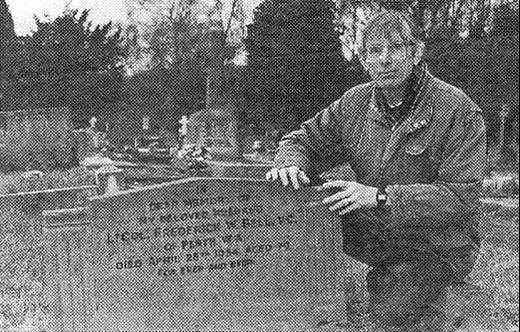
Bristol Journal photo.
Two phone calls came on the day of publication, before I had even seen the article myself. It was nice to get them, but the callers had no information to give - they just wanted a chat! The next day began the start of an amazing series of calls and letters. The first came from a retired, but not very old, ex officer in the British Army currently engaged in writing a doctoral thesis on aspects of late Victorian Australia; he was in collaboration with an Australian colleague, also with a military background, whom he rang each week in Australia. The caller, John Black, said he would raise the matter with his Australian colleague when he rang the next day - the common military background offering a real chance of progress. John then went on to describe the exact stage of the Boer War during which FW had gained his medal. The Boers had retreated to the hills and the War was largely of a guerrilla type - hence the use of mounted infantry. A later phone call from John indicated that his colleague had actually found a photo of FW in Australia!
The next day - a Sunday - my wife and I returned from a walk to find a message on our answer phone. The caller said that if I rang back he thought that he would have something to interest me. I rang and the caller, Clive Seward, said that about 15 to 20 years ago, before he moved to his present house, he lived next door to a Mrs Bell; he had a memory that she had said that her deceased husband had held the VC. He also had a memory that Mrs Bell had moved to Oxford to live with a daughter, probably from a previous marriage. I asked if she were Australian. The answer was a very firm: "No - a more prim and proper English lady would be hard to find". Clive went on to say that a Mr and Mrs Paul had lived opposite and they had been active with the Royal British Legion. He knew that Mr Paul had died, but he thought that Mrs Paul was still alive and that she could well know a bit more about the Bells than he did. I then asked him where the Bells had lived. He told me that it was 89 Stoke Lane, Westbury-on-Trym - I was dumbfounded, for I live at 194 in the same road. FW had lived only 400 yards from my present house!
The next day my wife and I visited number 89. The present owners, George and Mary Banting, knew of FW. Mary, additionally, had a great interest in the previous owners of their house (they were the 10th); she had a complete list of all the transactions, including dates and sale prices. She was able to tell me that the Bells had moved from "Darklands", Symonds Yat, Hereford, that Mrs Bell herself had purchased the house on 11th July 1952 and that she had sold it on 7th October 1980, some 26 years after her husband had died.
The next thing I did was to look for Mrs Paul's phone number - there was no entry in the book. She was either dead, moved away or ex-directory in that order. In any case, the chances of contacting her seemed remote. Never-the-less a call to my contact in the Legion looked worthwhile and so I rang. I described the situation and was immediately told that Mrs Paul was still the Legion's Standard Bearer. Subsequently it turned out that Mrs Paul knew very little about Mrs Bell: "she kept herself to herself".
With this news, any Australian connection seemed tenuous - the search would need to concentrate on Britain, probably Oxford. However, I still needed more information about FW himself. It struck me that, since he had the VC, there could well have been an obituary published in The Times. At home we have a copy of "Obituaries from The Times 1951-60". FW died in 1954 and it was therefore worth a look - no luck. Closer examination of the book however showed that it was clearly a selection; the entries were mainly for nationally and internationally prominent people. Perhaps there had been an obituary after all.
Bristol is a large city with a marvellous Central Reference Library, which includes a newspaper section. A trip there was called for. I asked the receptionist for copies of The Times for 1954 to be told that they were all on microfilm. The 1954 index was then given to me and in a very few moments I found an entry "Lt Col FW Bell VC; obituary" with details of the date, page number and column for the actual edition (Saturday 1st May 1954). What I found on the microfilm read:
"Lt Col Frederick William Bell, who won the Victoria Cross for conspicuous gallantry at Brakpan in the South African War, died at Bristol on Wednesday at the age of 79.
He won the decoration on May 16th, 1901, at Brakpan. He was retiring under heavy fire after holding the right flank when he saw a colleague who was dismounted. In spite of the intensity of fire he turned about, went to the man's aid, and took him up behind him on his horse. The weight of the two men proved too great for the animal, which fell with them. Bell thereupon insisted that the man should mount the horse and make his escape. Bell remained behind and covered his retirement until he was out of danger. Bell also saw active service in Somaliland and later in the 1914-18 War.
He later served as a political officer in British Somaliland and as an administrative officer in both Nigeria and Kenya Colony. He retired from the colonial service in 1925 and at the time the circumstances surrounding his retirement received a considerable amount of prominence. The late Lord Delamere moved a resolution in the Administrative Assembly of Kenya drawing the attention to "the reprimand and notice of termination of his services, given by the Government to Lt Col FW Bell VC, a District Commissioner, following his evidence before the Masai Inquiry Committee". The Government contended that Bell's retirement had been previously recommended on the ground that he had reached the age limit, and that it was not connected with the evidence that he had given."
from David Harvey's book "Monuments to Courage"
The account of FW's deed was better than that given in the VC Association book (see also footnote (2)), but what was this "reprimand and termination of services"? What had he done? More research was obviously needed! I therefore went back to the Reference Library and looked up "Masai Inquiry Committee" in the 1925 index. I found an entry for 23rd April, page 11 which read:
"Reprimand of Kenya Official
Lord Delamere's Criticisms (from our correspondent). Nairobi April 20th
In the Kenya Legislative Council Lord Delamere moved a resolution drawing attention to the reprimand and notification of termination of his services given by the Government to Col FW Bell VC, a District Commissioner, following his evidence before the Masai Inquiry Committee.
Lord Delamere stated that Col Bell had given evidence that certain sums of the Native Trust Fund earmarked for certain purposes had been diverted to other purposes; also that he was ordered to send askaris (native troops) to round up Masai children, who were forced to attend school against the wishes of their parents; and further that he had characterized permission given to superior officers to allow Masai warriors to maintain their war-like insignia as very injudicious.
The resolution was defeated. The Government contended that Col Bell's retirement was previously recommended because he had reached the age limit and was not connected with the evidence, although it was true that action was not taken in regard to Col Bell's retirement until the evidence was given. The Government stated that it retains the right to censure officials who criticize the policy of their superiors, even when giving evidence. It also denied the truth of the allegations made.
Lord Delamere, in the same resolution, asked the Government to abandon the practice of instructing natives beforehand as to the evidence they were expected to give, and quoted a statement of Col Bell that he had been ordered to hold a meeting of the Masai for this purpose before the sitting of the Committee. The Government denied tampering with witnesses, asserting that it endeavoured to assist the Inquiry, but Lord Delamere regarded it as significant that the native speeches which were delivered to the Parliamentary Commission had been typewritten beforehand. He said he was fighting for principles and had no personal interest to serve."
I later found out, in an entry in The Times for 24th June 1924, that Lord Delamere had been a member of the Inquiry Committee (I never did manage to find out why the Committee had been set up in the first place). It was crystal clear that Lord Delamere had been deeply disturbed by the treatment handed out to FW whose only "crime" seems to have been that he told the truth about matters which the Government didn't wish to accept - was it not ever so? FW was not only a brave man, but also an honourable one who suffered for his honesty.
Just before I found out about the Masai Inquiry, on 16th March, I had a totally unexpected letter from a John Woodgate. He introduced himself somewhat apologetically and went on to say that he had read the article in the Journal and taken the liberty of transcribing it onto the Internet. John has a great interest in genealogy and had been largely responsible for setting up an international genealogy group on the Net. He has contacts around the world and had sent the transcription particularly to contacts in Australia. He enclosed an e-mail that he had received from Rob Nelson in Perth with a mine of information about FW! It was unbelievable. Further e-mails and other documents followed (2) to reveal much of the life and background of FW (3 & 4) and the respect he has in his native West Australia. Based mainly on this information it is now possible to draw up a comprehensive account.
Summary of the life of Lt Col FW Bell VC
Born in Perth, W Australia 03/04/1875. His paternal grandfather was George Bell (b. UK 1818; d. W Australia 29/11/1908). On 24/01/1846 George married Lydia Charlotte Duffield (b. UK 04/06/1829; d. W Australia 23/07/1915). George arrived on the "Napoleon" in Fremantle in 1840 (by 1865 he's listed as a carpenter in the WA Almanac). Lydia and her mother arrived with early settlers in about 1831, her father, John Hole Duffield, (FW's maternal grandfather) having arrived in Fremantle on HMS "Warrior" in 1830. They had 12 children between 1846 and 1872, 7 girls and 5 boys. Henry Thomas (1848-1923), Lt Col Bell's father, was the second child.
In 1871 Henry Thomas married Alice Agnes Watson (07/05/1853 - 04/09/1936); they had 10 children between 1873 and 1894 and FW was the second.
Of his siblings the eldest, Luna Alice (25/04/1873 - ?), married a Mr Cox and was living in the UK in 1936. Two of his brothers served in the Australian Imperial Force in WW1; Edgar was killed at Gallipoli and Bert at Pozieres in France. For more family details see " Appendix".
FW was initially in the W Australian Customs Dept, joining as a cadet in 1894; he later became a cashier.
Fred prior to enlistment. Possibly outside his mother's place in Cottesloe, a beach suburb of Perth, WA or outside a Stirling Street, Perth address. Source: John Bissett, WA (the house was later confirmed by Robert Dethridge not to be that of FW's mother - see near end of this account)
In October 1899, at the outbreak of the South African War, he enlisted as a Private in the 1st West Australian (Mounted Infantry) Contingent. (At this stage of the development of Australia the individual States acted on their own in these matters: only in 1901 did the States combine to produce an "Australian" army).
WA Transvaal Contingent lining up on Karrakatta station, near Perth, 7th November 1899. Fred is listed as one of those present - he was a Private at the time.
Souce: Aldon George, via John Sweetman and John Bissett.
FW as a young soldier.
Source: John BissettHe first saw action at Slingersfontein, and later took part in the relief of Johannesburg and Pretoria and the battles of Diamond Hill and Wittenbergen: on 19th July 1900, in a sharp engagement at Palmeitfontein, he was seriously wounded in the abdomen and invalided to England. He returned to Perth in February 1901, was commissioned Lieutenant in the 6th Contingent on 8th March and re-embarked for South Africa
He gained the VC at Brakpan in the Transvaal for bravery in action. He was the first W Australian to achieve this honour. Details of his action were carried in the London Illustrated News of October 12th 1901, pages 534 and 535, along with two other VC medal winners from different actions.
Note the remarkable likeness between the earlier photos and the artist's image.
All Crosses are engraved with the date of the action on the back and the recipient's name on the back of the Clasp. However FW was originally presented with an unengraved Cross in South Africa, one of several taken out for presentation in the field by the then Prince of Wales, later King Edward VII. It was returned to the War Office for engraving. In the meantime another Cross with FW's name on it had been prepared for presentation and sent separately to South Africa, but it was later melted down. (There is another version of this story which says that the medal was presented by the Prince to FW in London on 11th July 1902).
After his discharge in May 1902 he joined the Australian section of the Coronation Escort for King Edward VII. He then settled in Perth, but returned to England, joined the Colonial Service in 1905 and was appointed to British Somaliland as an Assistant District Officer in April.
He became an Assistant Political Officer later that year, a post which he held until 1910. He took up big game hunting and, in 1909, narrowly escaped death in a lion hunt. He found himself alone as a lion charged. He shot it, but managed only to infuriate it by blowing away its lower jaw. The lion and he wrestled in the dust until help arrived. He spent six months in England recovering from the mauling.
He became Assistant Resident in Nigeria in 1910 and an Assistant District Commissioner in Kenya in 1912. In 1914 he became ill and was sent to England to recuperate.
At the outbreak of WW1, on the eve of his recovery, he immediately volunteered for service. (In 1907 he had been commissioned in the 4th Reserve Regiment of Cavalry). He went to France with the Royal Irish Dragoon Guards. He was mentioned in dispatches and promoted to Captain in October 1915. He was also wounded again. He returned to England and was made Commandant of a rest camp and promoted to Major; later he was made Lt Col and became the Commandant of the Embarkation Camps in Plymouth.
FW as a captain in WW1. Source - "The Duffields of Bicton" (see Appendix), via John Bissett.
After the War he became a District Commissioner in Kenya.
In May 1922, aged 47, he married in London to Mabel Mackenzie Valentini (nee Skinner), a divorcee. She died in 1944.
In 1924/25 he gave evidence at the Masai Inquiry Committee at which his evidence appeared to displease the Government; he was retired in 1925, allegedly on the grounds of age - he was 50 at the time. The Government denied the allegations he gave under oath to the Inquiry.
He remarried on 20th February 1945 to Brenda Margaret Cracklow (nee Illingworth), a widow. At this time he was 69.
He visited W Australia with his wife in 1947 and took part in a ceremony with other holders of the VC.
Prior to 1952 he lived at Darklands, Symonds Yat, Hereford. He moved to 89 Stoke Lane, Westbury-on-Trym, Bristol following the purchase of the house by his wife on 11th July 1952.
He died in Bristol on Wednesday 28th April 1954 at the age of 79. He is buried in Canford Cemetery, Bristol. An obituary appeared in The Times on Saturday 1st May 1954. His wife continued to live in the house, apparently with Mary Brenda Cracklow, her retired secretary but also probably an unmarried Sister-in-Law from Mrs Bell's first marriage.(5).
Lt Col Bell had no children of his own.
In 1979 W Australia celebrated the 150th anniversary of its first settlement. 150 brass plaques were placed in the pavements of Perth; his details are on the one for 1901.
In 1984 a medal dealer offered his VC (and other medals) for sale to the family in WA. The asking price was apparently A$43,000, possibly for the VC only. The medal had been sold much earlier (details unknown, but possibly by his widow or step son) and went to Canada. See (5) and last paragraphs of this text.
It then reappeared on the market in London from where the offer to the family came. In view of the price the family were forced to decline the offer. However the WA Government was alerted about the sale and made arrangements for one of their representatives to make the acquisition. The story hit the WA newspapers on 12th Oct. 1984. The medals are now on permanent display in the WA museum. The medals, 10 in all, consist of the VC; Queen's South Africa Medal (clasps for Wittenbergen, Diamond Hill, Johannesburg, and Cape Colony); King's South Africa Medal (clasps for South Africa 1901 and 1902); Africa General Service Medal (clasp for Somaliland 1908-10); 1914-15 Star, British War Medal, Victory Medal with Oak Leaf (Mention in Dispatches), Coronation Medals for Edward VII, George VI and Elizabeth II.
In 1991 a permanent display about him was placed in the foyer of the Customs Department in Fremantle.
So far 3 relatives had been traced, all in WA, all children of FW's brother Harry George (22/02/1879 - 03/08/1962). Others came to light later.
In one of Rob's e-mails he said that he would be in contact with both the W Australian Customs Service and the W Australian Government in the hope that some money to help restore the grave might be available. He also said that the relatives, some of whom he had actually spoken to, had no objection to the grave being restored. With a view to helping his campaign I made short videos of FW's house in Stoke Lane, Canford cemetery where he's buried, his grave and sent these off to Rob on 25th March.
Rob had also indicated that the Western Australian Museum, where FW's medals are displayed, had a great interest in discovering how they came to end up in Canada; he had spoken to the W Australian medal dealer who had been offered the medals in 1984 and had been told that the medals had been found in Canada by the London firm of Spink; the name of another London intermediary was also given. On 1st April I rang Spink in London; they knew of the intermediary and said they would make enquiries and ring back. This they did about six hours later, but the news was not good. They themselves only had records back to 1986 and other sources had no records. It seemed then we could get no further with the saga of the "lost" medals. Pity (6).
In return for all the information from Australia I was asked to try to find out more about FW's English period after his forced retirement. I knew that the address where he and his second wife lived prior to their removal to Bristol was "Darklands, Symonds Yat, Hereford". Back in 1952, when they moved to Bristol, Symonds Yat lay right on the border of Monmouthshire, Herefordshire and Gloucestershire. Monmouthshire and Herefordshire no longer exist as separate Counties. Where was I to turn? I put off the decision until mid May when I rang the General Property Services of Bristol City Council. They were a bit bemused by my request of help as to where to look for information; never-the-less, after some internal consultations, they suggested that I rang Gwent County Council, since they thought that Symonds Yat was now in that domain. BT rapidly gave me the correct phone number and again, after some internal discussions, in which it became clear that they had no records, they gave me the number of the Hereford Record Office, which still exists as a separate entity in spite of the County now being Hereford and Worcester. I rang and told them the information that I was trying to gain about FW. There and then they checked the Electoral Registers, but with no result; they next turned to Kelly's Directory for 1941 and discovered that FW, presumably with his first wife who died in 1944, lived at "Pengwyn", Symonds Yat. They also told me that a Mrs Cracklow was living at "Darklands", Symonds Yat. (Mrs Cracklow was FW's second wife whom he married in 1945). They then checked the 1934 Directory and established that both FW and Mrs Cracklow were at the same addresses. Unfortunately the next oldest Kelly's that they had was for 1922, when I knew that FW was still in Kenya. All of this Hereford information came over the phone in the course of about 20 minutes.
It thus appears that FW lived in Symonds Yat - a very beautiful part of the world incidentally - at least from 1934. Initially he was with his first wife, whom he married in London in 1922. She died in 1944 and about a year later he married Mrs Cracklow, a widow, whom he must have known for many years since they both lived in the same area. When his first wife died he moved into "Darklands", owned by Mrs Cracklow and it was for this reason that she, and not he, purchased the house in Bristol. Whether he ever owned "Pengwyn" or merely rented, I don't know. However, see (5).
I now regarded FW's story as complete. I submitted an account of my searches to The Military History Society of Australia and they were delighted to publish it in their journal Sabretache - the address having been given me by John Black. (Sabretache 1997:38/2:3-12)
However, there was still the problem of the grave. In late August it became clear that the Royal British Legion had been successful in their efforts to find names to go on the War memorial - 127 were eventually found. I thought another approach might be worthwhile. The outcome of this was that, with their great help and especially that of Brigadier Joe Starling, the money for refurbishment was found just before Remembrance Sunday 1996. The BBC were sufficiently interested to make a short film for TV and an interview for radio; they even did a live interview with Rob Nelson! Tragically, Joe Starling died a few weeks later, after a long illness.
The story did now seem complete. I had heard from the stonemason that the actual refurbishment would take place in a few weeks, in very early January 1997. I sent a copy of the Radio Bristol interview to Rob Nelson and closed my folder on FW, only to have to open it again a day or two later! Georgina Harvey, the BBC reporter who had set up the radio and TV interviews rang and said that the Australian press were interested in the story; could I please give her another interview and take her to the grave so that she could take some photos. A suitable date was made and she took her photos and made notes. I expressed some doubt about the chances of her piece ever being printed, but she seemed confident.
All went quiet again until lunch time on Sunday 15th December when a man rang our door bell and said that he was Barry Southgate and that he lived around the corner. He had just come back from Perth in W Australia where, on Sunday 8th December in the WA Sunday Times he had read an article by Georgina which described my efforts to find out about FW. He had been fascinated with the story and wondered if I would like the appropriate page to keep, since he'd bought it all the way back with the object of letting me have it! My doubts about Georgina's contacts were clearly unwarranted and I was dumbfounded yet again.
The paper carried a second piece, this time about FW's medals and how they came to Australia via Canada. Apparently FW's step-son had emigrated there and it was he who had sold it to the London dealer. Another piece of the jig-saw had fallen into place (6).
Christmas Eve bought an unexpected letter from Australia - from Edward Keenan a great grandson of Rosetta, one of FW's aunts. He too gave me a copy of the article; he also thanked me deeply for my efforts with the grave! (7). (Edward Keenan died in early 2004.)
I now felt FW's story to be well and truly told and, as promised, in mid January 1997 his grave was neatly restored. A final twist came at about 8.30am on 7th March 1997. Our phone rang and the voice at the other end said that he was a John Bissett (3), ringing from Perth in WA. His wife was a great niece of FW; they too had seen the newspaper article and could I please tell them more! I sent them a copy of the story and gave them Edward Keenan's address - they didn't know of him. Later, in June 2000 on a European holiday, they visited us and saw the grave. They told me that a street had recently been named after FW - FW Bell Parade, in the Perth suburb of Victoria Park after new evidence revealed that FW had lived there for a few months working as a local government employee.
In October 1997, I deposited all my papers about FW in the newly opened Empire and Commonwealth Museum housed in Isambard Kingdom Brunel's old (1830) railway station in Bristol.
A couple of years passed and, on 16th May
2001 the centenary of Fred's deed was honoured with a
ceremony around his grave. I had alerted the Royal British
Legion of this anniversary. They arranged, and paid for, a
further refurbishment of the grave, which had become a little
green since 1997. As well as the Legion's representatives
those present also included JN Tidmarsh, MBE, JP, the Lord
Lieutenant of Bristol, Lt Col Mike Phelps, Australian Army
and Col Brian John, the head of the local branch of the Royal
British Legion. Wider coverage had been given on 1st May by
the Bristol Times, a weekly historical supplement to the
Bristol Evening Post, which published a half page article on
the results of my efforts to find out more about Fred.
The ceremony itself, conducted by Canon Roy Harrison,
Chaplain to the Gloucestershire County branch of the Legion,
consisted of a simple 30 minute grave-side service with flag
bearers and a bugler from the Legion. Very dignified and
appropriate. Fred would have been extremely proud. The sun
even shone!

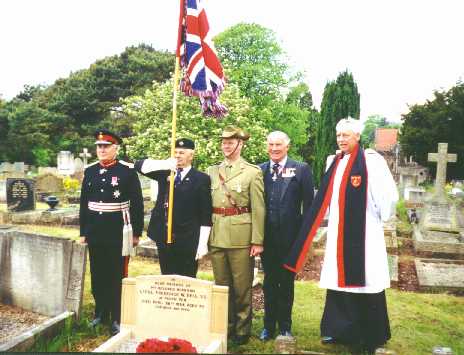
JN Tidmarsh, MBE, JP, the Lord Lieutenant of Bristol, a Royal British Legion flag bearer, Lt Col Mike Phelps, Australian Army, Col Brian John, the head of the local branch of the Royal British Legion and Canon Roy Harrison, Chaplain to the Gloucestershire County branch of the Legion.
Although I had long thought Fred's story to be complete, in August 2003 I was surprised, yet again, to receive a series of messages from his Canadian step family. Some years later I was asked to remove all the correspondence from this web site. The picture of Fred's miniatures, still then in Canada, came at the same time, but this will stay.
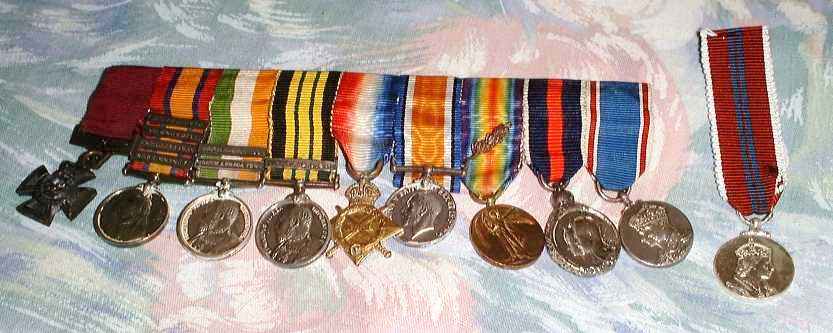
In early September 2004 I was sent details of FW's Death Certificate. He died in Stapleton Hospital, Bristol, which I know had previously been 'Stapleton Workhouse', later Manor Park Hospital and is currently called Blackberry Hill Hospital. His death was certified as due to 'Arteriosclerosis'.
With these clarifications, and the eventual fate of the miniatures, this must surely be the final chapter of FW's life.
However, life is full of surprises and, on 11
July 2004, I had the following message from Peter Enlund East Burwood, Victoria, Australia.
"You have cited the "Duffields of Bicton" book and
I have direct links with the Bell family. I am first cousin five
times removed to a Rosetta Bell, George's sister, b on 20
February 1812 in Greenwich. Lydia and George had a daughter, also
named Rosetta and so we can see where the name comes from. George
also has cousin, Rosetta Rebecca Bell, who is my third great
grand-aunt. Her grandfather, Henry Trubshaw BELL b 1752 is my
fifth great grandfather.
I have been researching the Bell family for less than a year but
have had great success in tracing it from afar. It was just
yesterday that I received some research from the London
Metropolitan Archives with the baptismal records of Henry
Trubshaw BELL and a few of his relatives back to 1695. I had
already ascertained that George Rutledge had married into the
family and learned of his journeys to Australia. The fact that
his George Bell accompanied him was a bolt out the blue as is the
history that has been documented by the Duffields of South
Australia."
In September 2005 another set of messages and photos arrived. The text included:
"Hi James,
My name is Robert Dethridge. I am a grand nephew of Fred Bell. My mother Betty
(nee Bell) being one of Fred's brother Harry George Bell's children.
Some years ago, I read our local Sunday Times story about your wonderful efforts
in bringing Fred's resting place and history to light but I only happened across
the full story on the internet this week.
I was moved by the sheer effort and sincerity displayed in your research and the
on flow of activity from it.
I am contacting some of my other Bell related cousins and printing off copies of
your story for those that may not have internet access.
Only one of Fred's nieces, Pat Bell (86) presently survives. Pat would have met
Fred but, unfortunately, she is suffers dementia.
Myself, my sister and my cousins have some mementos of Fred but, in line with
modern day relatives, exactly what we hold I cannot say.
I personally have 2 faded and moth eaten photos of Fred in full officer's
uniform, previously having rested in on the piano of his sister Eva Bell's house
in Cottesloe (a house gifted to her by Fred) for about 65 years or so. One is
signed, both around 1916.
I still live in Cottesloe and recollect our Aunt Eva telling us stories about
Fred and his brothers. I knew the Bell house in Cottesloe very well (my mother
inherited it) and it is not the one in the photo behind the early shot of Fred
on a pony.
I also have an 1947 story from our local press with a photograph of Fred meeting
the last Western Australian to win a VC. Story entitled "First Meets Last".
An oil painting by his artistic sister, Luna, hangs on my lounge room wall as
does a photo of his brother Bert.
Fred was possibly Cottesloe's first real hero. His photograph hung on the main
wall of City of Cottesloe council chambers for over 80 years (it may still be
there). The only other photograph on the same wall being of the King or Queen at
the time."
|
|
Fred has written a dedication to his mother on
the reverse side. It is dated 10.09.16. |
In 2005 a chance contact with Anthony Staunton, the current editor of Sabretache, led to a request to update the story which had been published in 1997. In March 2006 this update appeared in Sabretache, 47,1: 17-22:2006.
In early February 2008 I had a message from Arthur Ventham in Perth, WA. He
works for the Government of WA and included in this message was:
"Prior
to joining the WA State Government I was a Senior Customs Officer at Fremantle
and was instrumental in having F. W. Bell’s photograph displayed in the foyer of
the new (back then) Customs House. I also spent 30 years in the Army retiring
as a Major and have always been proud of WA’s first VC winner".

FW's grave 9th July 2009 after removal of the encroaching convolvulus!
In September 2011 Kevin Gummett from Canford Lane informed me that the Australian government were searching for all the graves of Australian VC holders around the world. The Veteran Affairs Minister wished to ensure that they are protected and maintained, wherever they may be. Kevin's cousin, Don Barrett in Brisbane, who had visited the grave with Kevin, had already informed he Ministry about Fred's grave and they were very grateful for the information.
On April 20th 2013 I visited Fred's grave, just one week after my previous visit. In the interim the grave had been restored again! I suspect that this was organised by a local VC enthusiast who, at his own expense, had paid several £1000s for a grave restoration in Redland Chapel. I have lost his contact details, but below is a picture I took of the grave on 20th April. A few weeks later I noticed a printed plaque at the end of the grave, which gave a clue to the restorer. The gravel had also been renewed.


James Briggs
E-mail address:
Updated 18 May 2013
Back to Author's Main Home Page
Visits since counter added on 12 Feb 2007View My Stats
